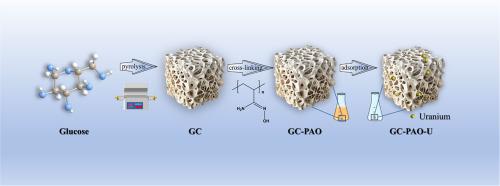Adsorption performance and mechanism of polyamidoxime-coated glucose derived biochar for separation of uranium from nuclear wastewater
IF 6.3
3区 工程技术
Q1 ENGINEERING, CHEMICAL
Journal of the Taiwan Institute of Chemical Engineers
Pub Date : 2025-09-19
DOI:10.1016/j.jtice.2025.106408
引用次数: 0
Abstract
Background
Efficient removal of uranium from uranium-containing nuclear wastewater is of great significance for national defense security and environmental protection.
Methods
We synthesized a polyamidoxime-coated glucose-derived biochar (GC-PAO) adsorbent and systematically investigated its adsorption mechanism using Scanning electron microscopy (SEM), Brunauer-Emmett-Teller (BET), Fourier-transform infrared spectroscopy (FTIR), Raman spectroscopy (Raman), Synchronous thermal analyzer (STA) and X-ray photoelectron spectroscopy (XPS).
Significant findings
The optimized adsorbent, GC-850/3.6-PAO, has a pore structure suitable for adsorption with a high content of amidoxime functional groups through careful selection of the carbonization precursor, chemical catalyst and pyrolysis temperature. By adsorption experiments at pH = 6, the maximum adsorption by GC-850/3.6-PAO adsorbent in 32 ppm uranium spiked solution was 565.36 mg·g-1. Meanwhile, GC-PAO also has good reusability. The adsorption capacity of Uranium (VI) remained at 402.63 mg·g-1 after 5 repetitions. Kinetics, thermodynamics and XPS research revealed the surface complexation mechanism between the uranium (VI) ions and the amidoxime groups. It has demonstrated good adsorption capacity in simulated nuclear wastewater containing various ions. Under the enhancement of photothermal effect, the uranium adsorption capacity of GC-PAO for nuclear wastewater reached 512.96 mg·g-1 within 4 h. Therefore, the GC-PAO composite adsorbent can be considered as a potential candidate for the treatment of radioactive nuclear wastewater.

聚偕胺肟包被葡萄糖生物炭对核废水中铀的吸附性能及机理研究
从含铀核废水中高效脱除铀对国防安全和环境保护具有重要意义。方法合成了一种聚偕胺肟包被葡萄糖衍生生物炭(GC-PAO)吸附剂,并利用扫描电镜(SEM)、布鲁纳尔-埃米特-泰勒(BET)、傅里叶变换红外光谱(FTIR)、拉曼光谱(Raman)、同步热分析仪(STA)和x射线光电子能谱(XPS)对其吸附机理进行了系统研究。通过对炭化前驱体、化学催化剂和热解温度的精心选择,优化得到的吸附剂GC-850/3.6-PAO具有适合吸附偕胺肟类官能团含量高的孔结构。在pH = 6条件下,GC-850/3.6-PAO吸附剂对32 ppm铀的最大吸附量为565.36 mg·g-1。同时,GC-PAO还具有良好的可重用性。重复5次后,对铀(VI)的吸附量仍保持在402.63 mg·g-1。动力学、热力学和XPS研究揭示了铀(VI)离子与偕胺肟基之间的表面络合机理。对含多种离子的模拟核废水表现出良好的吸附能力。在光热效应的增强下,GC-PAO对核废水的铀吸附量在4 h内达到512.96 mg·g-1,因此,GC-PAO复合吸附剂可作为处理放射性核废水的潜在候选材料。
本文章由计算机程序翻译,如有差异,请以英文原文为准。
求助全文
约1分钟内获得全文
求助全文
来源期刊
CiteScore
9.10
自引率
14.00%
发文量
362
审稿时长
35 days
期刊介绍:
Journal of the Taiwan Institute of Chemical Engineers (formerly known as Journal of the Chinese Institute of Chemical Engineers) publishes original works, from fundamental principles to practical applications, in the broad field of chemical engineering with special focus on three aspects: Chemical and Biomolecular Science and Technology, Energy and Environmental Science and Technology, and Materials Science and Technology. Authors should choose for their manuscript an appropriate aspect section and a few related classifications when submitting to the journal online.

 求助内容:
求助内容: 应助结果提醒方式:
应助结果提醒方式:


